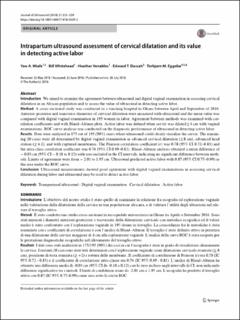| dc.contributor.author | Wiafe, Yaw A. | |
| dc.contributor.author | Whitehead, Bill | |
| dc.contributor.author | Venables, Heather | |
| dc.contributor.author | Dassah, Edward T. | |
| dc.contributor.author | Eggebø, Torbjørn Moe | |
| dc.date.accessioned | 2021-05-10T06:55:56Z | |
| dc.date.available | 2021-05-10T06:55:56Z | |
| dc.date.created | 2018-10-03T14:53:40Z | |
| dc.date.issued | 2018 | |
| dc.identifier.citation | Journal of Ultrasound. 2018, 21 (3), 233-239. | en_US |
| dc.identifier.issn | 1971-3495 | |
| dc.identifier.uri | https://hdl.handle.net/11250/2754476 | |
| dc.description.abstract | Introduction
We aimed to examine the agreement between ultrasound and digital vaginal examination in assessing cervical dilatation in an African population and to assess the value of ultrasound in detecting active labor.
Method
A cross-sectional study was conducted in a teaching hospital in Ghana between April and September of 2016. Anterior–posterior and transverse diameters of cervical dilatation were measured with ultrasound and the mean value was compared with digital vaginal examination in 195 women in labor. Agreement between methods was examined with correlation coefficients and with Bland–Altman plots. Active labor was defined when cervix was dilated ≥ 4 cm with vaginal examinations. ROC curve analysis was conducted on the diagnostic performance of ultrasound in detecting active labor.
Results
Data were analyzed in 175 out of 195 (90%) cases where ultrasound could clearly visualize the cervix. The remaining 20 cases were all determined by digital vaginal examination as advanced cervical dilatation (≥ 8 cm), advanced head station (≥ + 2), and with ruptured membranes. The Pearson correlation coefficient (r) was 0.78 (95% CI 0.72–0.83) and the intra-class correlation coefficient was 0.76 (95% CI 0.69–0.81). Bland–Altman analysis obtained a mean difference of − 0.03 cm (95% CI − 0.18 to 0.12) with zero included in the CI intervals, indicating no significant difference between methods. Limits of agreement were from − 2.01 to 1.95 cm. Ultrasound predicted active labor with 0.87 (95% CI 0.75–0.99) as the area under the ROC curve.
Conclusion
Ultrasound measurements showed good agreement with digital vaginal examinations in assessing cervical dilatation during labor and ultrasound may be used to detect active labor. | en_US |
| dc.language.iso | eng | en_US |
| dc.publisher | Springer Nature | en_US |
| dc.rights | Navngivelse 4.0 Internasjonal | * |
| dc.rights.uri | http://creativecommons.org/licenses/by/4.0/deed.no | * |
| dc.title | Intrapartum ultrasound assessment of cervical dilatation and its value in detecting active labor | en_US |
| dc.type | Peer reviewed | en_US |
| dc.type | Journal article | en_US |
| dc.description.version | publishedVersion | en_US |
| dc.source.pagenumber | 233-239 | en_US |
| dc.source.volume | 21 | en_US |
| dc.source.journal | Journal of Ultrasound | en_US |
| dc.source.issue | 3 | en_US |
| dc.identifier.doi | 10.1007/s40477-018-0309-2 | |
| dc.identifier.cristin | 1617656 | |
| dc.description.localcode | Open Access This article is distributed under the terms of the Creative Commons Attribution 4.0 International License (http://creat iveco mmons .org/licen ses/by/4.0/), which permits unrestricted use, distribution, and reproduction in any medium, provided you give appropriate credit to the original author(s) and the source, provide a link to the Creative Commons license, and indicate if changes were made. | en_US |
| cristin.ispublished | true | |
| cristin.fulltext | original | |
| cristin.qualitycode | 1 | |

